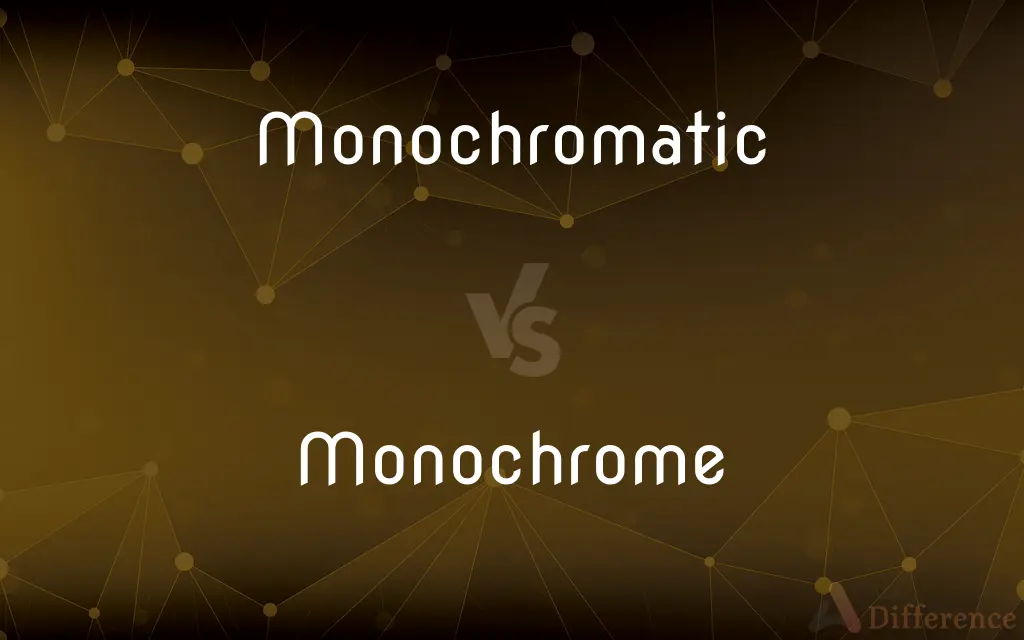Monochromatic vs. Monochrome — What's the Difference?
By Maham Liaqat & Urooj Arif — Updated on March 21, 2024
Monochromatic refers to shades of a single color, emphasizing variation in lightness, while monochrome typically means black, white, and gray tones, focusing on contrast without color.

Difference Between Monochromatic and Monochrome
Table of Contents
ADVERTISEMENT
Key Differences
Monochromatic designs utilize various shades, tints, and tones of a single color, creating depth and cohesion through the use of lightness and saturation differences. This approach is often used to establish a visual harmony and focus in art and design, where the consistent color palette evokes a specific mood or atmosphere. On the other hand, monochrome involves the use of one color, which traditionally includes black, white, and their intermediate grays. This method is popular in photography, print, and early film, where the emphasis is on texture, form, and contrast, rather than color.
While monochromatic schemes are celebrated for their subtlety and complexity, offering a soothing and focused aesthetic through the nuanced exploration of a single color's range, monochrome creations highlight the power of contrast and simplicity. The absence of color in monochrome work allows for a more pronounced focus on composition, light, shadow, and the intrinsic value of the subject matter, often leading to a timeless and classic appearance.
In the realm of interior design, monochromatic spaces use variations of a single hue to create a serene and cohesive environment. This strategy employs color psychology to evoke specific feelings, such as calmness or energy, depending on the chosen hue. Conversely, monochrome interiors rely on black, white, and gray to shape spaces defined by balance, sophistication, and a strong sense of formality. The lack of color directs attention to textures, shapes, and materials, crafting an elegant and defined space.
Monochromatic art and design often leverage color theory to enhance visual interest and emotional impact. By adjusting saturation and brightness, artists and designers can manipulate a single color to achieve a dynamic range of effects, from subtle to bold. Monochrome art, however, depends on the absence or limitation of color to explore visual texture, depth, and emotional resonance through contrast and composition, often resulting in striking and evocative imagery that transcends the need for color.
In fashion, monochromatic outfits create a unified and elongating effect by employing varying shades and textures of the same color. This stylistic choice enhances the wearer's silhouette and creates an effortlessly chic look. Monochrome fashion, while it can also refer to outfits in varying shades of gray or black and white, emphasizes simplicity and elegance, often using contrast to make bold statements and define the form.
ADVERTISEMENT
Comparison Chart
Definition
Involves shades, tints, and tones of a single color
Involves black, white, and gray tones, or variations of a single color
Focus
Variation in lightness and saturation
Contrast and texture without color
Application
Art, design, interior decorating
Photography, film, print, design
Visual Effect
Depth, cohesion, mood
Contrast, simplicity, timelessness
Common Uses
Fashion, painting, interior design
Black-and-white photography, minimalist art
Compare with Definitions
Monochromatic
Interior design focusing on one hue.
A monochromatic blue living room can feel both calming and cohesive.
Monochrome
Referring to print or images without color.
Early films were monochrome, relying on contrast to convey the story.
Monochromatic
Aimed at creating depth with one color.
The room’s monochromatic green scheme brought the outdoors inside.
Monochrome
Black, white, and gray only.
The photographer’s monochrome landscape captures the stark beauty of winter.
Monochromatic
Art that uses variations of a single color.
His monochromatic artworks play with light and shadow within a single hue.
Monochrome
Fashion incorporating black, white, and gray.
She wore a monochrome outfit to emphasize texture and form.
Monochromatic
In fashion, outfits of the same color hue.
Her monochromatic outfit in shades of red made a bold statement.
Monochrome
In design, using one color or shades of gray.
A monochrome palette in the kitchen can create a sleek, modern look.
Monochromatic
Utilizing shades of a single color.
A monochromatic painting might explore the depths of blue, from sky to navy.
Monochrome
Art that emphasizes contrast and form.
The artist’s monochrome drawings focus on the interplay of light and shadow.
Monochromatic
Having or appearing to have only one color.
Monochrome
A black-and-white image, as in photography or on television.
Monochromatic
Of or composed of radiation of only one wavelength
Monochromatic light.
Monochrome
A monochromic image is composed of one color (or values of one color). The term monochrome comes from the Ancient Greek: μονόχρωμος, romanized: monochromos, lit. 'having one color'.
Monochromatic
Done in monochrome
Monochromatic paintings.
Monochrome
A photograph or picture developed or executed in black and white or in varying tones of only one colour.
Monochromatic
Exhibiting monochromatism.
Monochrome
(of a photograph or picture, or a television screen) consisting of or displaying images in black and white or in varying tones of only one colour.
Monochromatic
Unvarying or dull
"the more prosaic and monochromatic aspects of communist life" (Amy Tan).
Monochrome
A picture, especially a painting, done in different shades of a single color.
Monochromatic
Having only one color, represented by differing hues and tints. For example shades in a black and white television.
Monochrome
The art or technique of executing such a picture.
Monochromatic
Perceptive of only one color; unable to distinguish colors; total color blindness.
Monochrome
The state of being in a single color.
Monochromatic
(figuratively) Plain, dull, lifeless.
Monochrome
A black and white image, especially such a photograph.
Monochromatic
Consisting of one color, or presenting rays of light of one color only.
Monochrome
(dated) A painting executed in shades of a single colour.
Monochromatic
Of or relating to monochromatism
Monochrome
A ceramic glaze of a single colour; an object so glazed.
Monochromatic
(of light or other electromagnetic radiation) having only one wavelength;
Monochromatic light
Monochrome
Having only one colour.
Monochromatic
Having or appearing to have only one color
Monochrome
(photography) Representing colours with shades of gray.
Monochrome
A painting or drawing in a single color; a picture made with a single color.
Monochrome
Painting done in a range of tones of a single color
Monochrome
A black-and-white photograph or slide
Monochrome
Having or appearing to have only one color
Common Curiosities
Can both monochromatic and monochrome techniques be used in the same artwork?
While uncommon, artists can combine both techniques to explore color, contrast, and texture in innovative ways.
xWhat is the main difference between monochromatic and monochrome?
Monochromatic involves variations of a single color, while monochrome means black, white, and gray tones or sometimes variations of one color.
Can monochrome be considered a type of monochromatic?
Yes, monochrome can be considered a specific case of monochromatic when it involves variations of a single color other than gray.
How do monochromatic and monochrome approaches affect mood in interior design?
Monochromatic interiors can evoke calmness or energy depending on the hue, while monochrome spaces often appear sophisticated and timeless.
Why do photographers often use monochrome?
Photographers use monochrome to emphasize textures, forms, and the emotional impact of a scene without the distraction of color.
Can monochromatic and monochrome styles be effectively combined in fashion?
Yes, combining monochromatic and monochrome elements in fashion can create visually striking outfits with depth, contrast, and elegance.
How does lighting affect monochromatic and monochrome designs?
In monochromatic designs, lighting can enhance color depth and mood. In monochrome designs, it accentuates contrast, form, and texture.
What role does texture play in monochromatic and monochrome designs?
Texture adds interest and depth to both monochromatic and monochrome designs, preventing them from appearing flat or monotonous.
Is monochromatic design easier to work with than monochrome?
This depends on the designer's intent; monochromatic schemes offer more color variety, while monochrome focuses on contrast and form.
Are monochromatic color schemes popular in modern design?
Yes, monochromatic color schemes are popular in modern design for their ability to create visually harmonious and aesthetically pleasing spaces.
Share Your Discovery

Previous Comparison
Addendum vs. Appendix
Next Comparison
Wreak vs. WreckAuthor Spotlight
Written by
Maham LiaqatCo-written by
Urooj ArifUrooj is a skilled content writer at Ask Difference, known for her exceptional ability to simplify complex topics into engaging and informative content. With a passion for research and a flair for clear, concise writing, she consistently delivers articles that resonate with our diverse audience.
















































